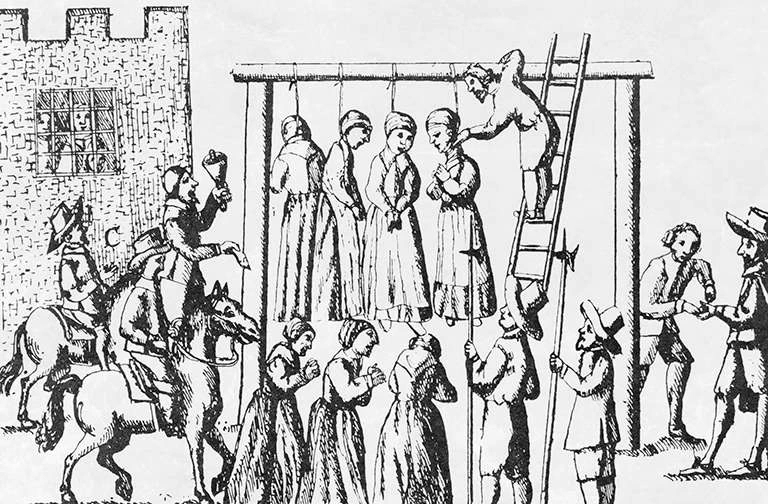Witch trials were conducted in England from the 15th until the 18th century, during which time up to 2,000 people were tried for witchcraft,[1] of whom fewer than 500 were found guilty and executed.[2] Although it is certainly the case that most of the accused were female – an estimated 90 per cent overall in England[3] – most of their accusers were also women.[1]
There was only one major witch-hunt in England, during the English Civil War (1642–1651), led by the self-styled Witchfinder General Matthew Hopkins
English witch-hunter who claimed to hold the office of Witchfinder General, although that title was never bestowed by Parliament. . Between 1644 and 1647 Hopkins and his associates were responsible for more people being hanged for witchcraft than in the previous 100 years,[4] more than 300 of them by 1646.[2] The historian John Callow has argued that the witchcraft trials and convictions following the Civil War were influenced by political and religious tension between nonconformist Whigs and the adherents of Anglican Toryism.[5]
Legal status
Witchcraft did not become a felony in England until the passage of Henry VIII’s short-lived Witchcraft Act 1542Series of Acts passed by the Parliaments of England and Scotland making witchcraft a secular offence punishable by death., although it had long been considered a crime by the Church, punishable in the ecclesiastical courts; but they had only limited powers to imprison, and could not impose fines or the death penalty.[6] The few witchcraft trials during the early Middle Ages were usually politically motivated, targeting the elite or those with ties to the elite,[7] such as Eleanor Cobham
English noblewoman and alleged sorcerer, forcibly divorced from her husband and sentenced to life imprisonment for treasonable necromancy., who in 1442 was sentenced to a lifetime of imprisonment.[8]
The 1542 Act, repealed in 1547, had failed to define what witchcraft actually was. Its successor, the Witchcraft Act of 1563, demanded the death penalty for witchcraft, but only if harm had been caused.[9] The Witchcraft Act 1604Series of Acts passed by the Parliaments of England and Scotland making witchcraft a secular offence punishable by death. broadened the scope of the earlier legislation to include the death penalty for those who invoked evil spirits or communed with familiarDemonic spirit who attends upon a witch, possessing magical powers that can be used for good or evil. Often taking the form of a small animal such as a cat. spirits.[10]
The Witchcraft Act 1735Sometimes dated 1736, an Act of Parliament that repealed the statutes concerning witchcraft throughout Great Britain, including Scotland. finally brought an end to prosecutions for alleged witchcraft in England after sceptical jurists, especially Sir John Holt (1642–1710), had already largely ended convictions of alleged witches under English law.
First prosecutions
There is no record of anyone having been prosecuted under the 1542 Witchcraft Act.[11] Elizabeth LowysFirst person to be prosecuted under the Witchcraft Act of 1563. was the first to be convicted under the 1563 Witchcraft Act, on 21 July 1564, but there is no firm evidence that she was ever executed.[12] Agnes WaterhouseElderly Essex woman convicted and hanged for witchcraft at Chelmsford in 1566., an elderly woman from Hatfield Peverel in Essex, is the first person known to have been convicted and executed under the Act, in July 1566.[3][13]
Decline
In the 17th century there was growing scepticism about the reality of witchcraft among the educated elite.[14] Many influential figures even considered it to be an impossible crime,[15] and the judiciary were becoming increasing sceptical of the evidence being presented in witch trials. During the 1712 trial of Jane WenhamLast person to be condemned to death for witchcraft in an English court, when she was found guilty at Hertford in 1712. a witness alleged that Jane was able to fly, at which her judge, Sir John Powell, is said to have commented that flying was not against the law.[16]
Final prosecutions
Alice Molland
Pehaps the last person to be executed for witchcraft in England. may have been the last person to be executed for witchcraft in England, in 1685, although no record remains of her trial or execution.[17] Better documented are the executions of the three Bideford witches three years earlier: Temperance Lloyd, Mary Trembles and Susannah Edwards.
Some sources claim that the last execution for witchcraft was that of Mary Hicks, in 1716. Her story is told in an eight-page pamphlet published that year, the Whole trial and examination of Mrs. Mary Hicks and her daughter ElizabethPamphlet purporting to tell the story of Mary Hicks, executed for witchcraft in 1716., but the story is considered by modern historians to be a journalistic invention.[18][19]
Jane Wenham was the last person to be sentenced to death for witchcraft in England, although her conviction was set aside. Her trial in 1712 is commonly regarded as the last witch trial in England,[20] but the last actually took place in 1717, ending with the accused being acquitted.[21]
See also
- Witch trials in early modern ScotlandJudicial proceedings in Scotland between the early 16th century and the mid-18th century concerned with crimes of witchcraft, part of a series of witch trials in Early Modern Europe.


